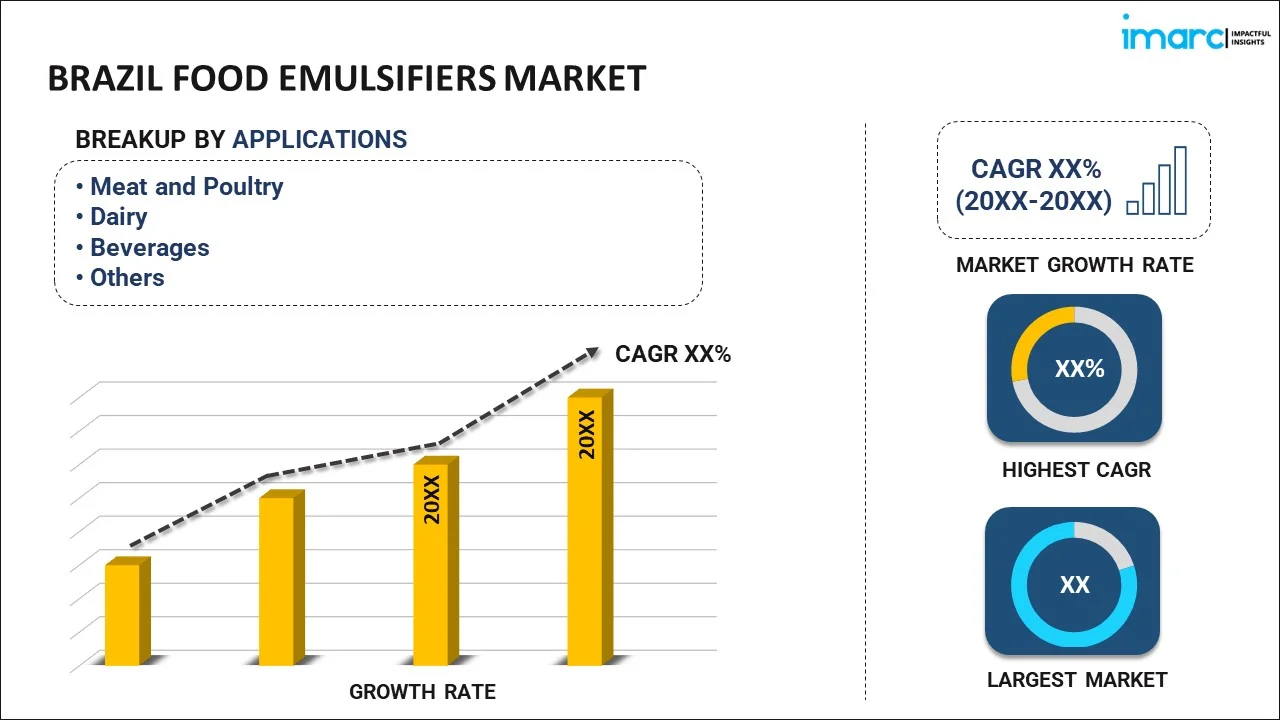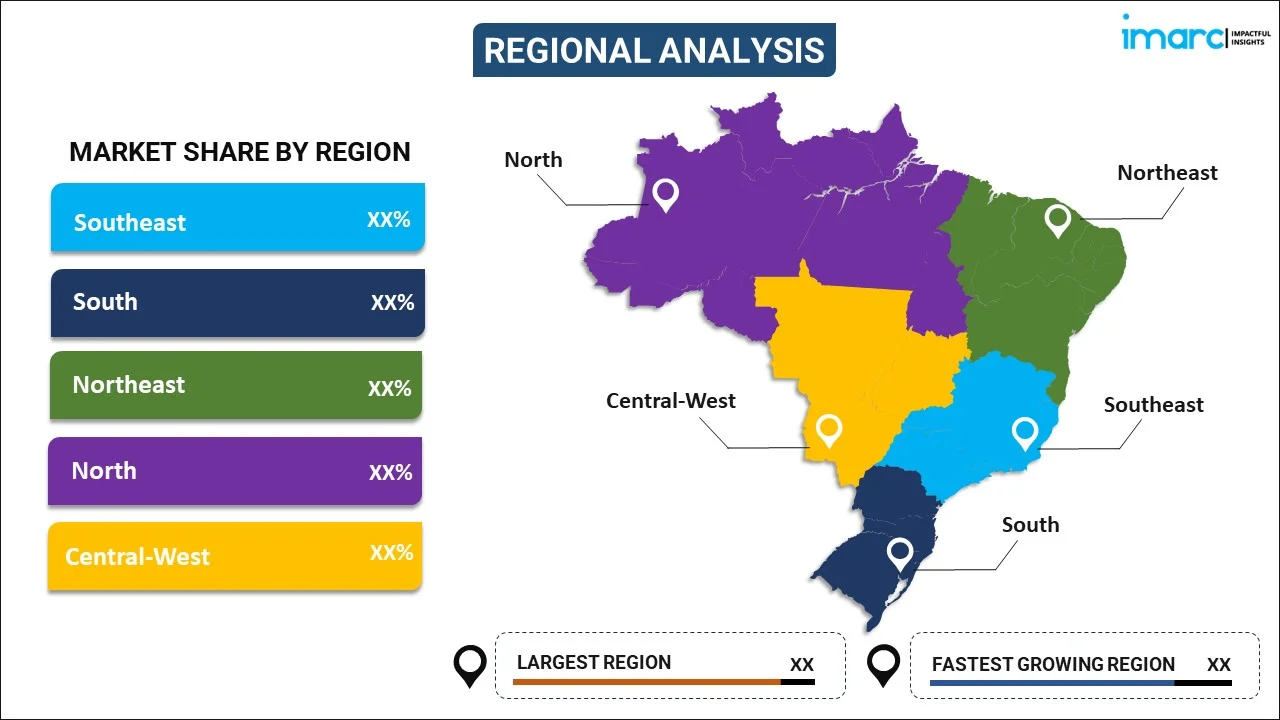
Brazil Food Emulsifiers Market Report by Application (Meat and Poultry, Dairy, Beverages, Bakery and Confectionery, and Others), and Region 2025-2033
Market Overview:
Brazil food emulsifiers market size reached USD 201.4 Million in 2024. Looking forward, IMARC Group expects the market to reach USD 310.1 Million by 2033, exhibiting a growth rate (CAGR) of 4.3% during 2025-2033. The growing demand for processed food, rising awareness and emphasis on clean labels and natural ingredients, and increasing online grocery shopping and the accessibility of food products through digital channels represent some of the key factors driving the market.
|
Report Attribute
|
Key Statistics
|
|---|---|
|
Base Year
|
2024 |
|
Forecast Years
|
2025-2033
|
|
Historical Years
|
2019-2024
|
| Market Size in 2024 | USD 201.4 Million |
| Market Forecast in 2033 | USD 310.1 Million |
| Market Growth Rate (2025-2033) | 4.3% |
Food emulsifiers facilitate the stable blending of usually unmixable components, such as oil and water. They encompass lecithin, an emulsifier derived from sources like soybeans and egg yolks, which is a natural choice extensively employed in the realms of baking and confectionery. They also consist of mono- and diglycerides that are synthetic emulsifiers found in bread and bakery items for their ability to enhance dough stability and texture. They include polysorbates and sorbitan esters, serving to ensure consistent textures and maintain the desired consistency. They also encompass sodium stearoyl lactylate, employed to enhance the crumb structure of various food items and extend their shelf life. They possess a molecular structure featuring both hydrophilic (water-attracting) and lipophilic (fat-attracting) regions. Their functionality is contingent on specific pH levels and temperatures and they can interact with other constituents in a food formulation to influence the stability and texture of the end product. They play a crucial role in extending the shelf life and preserving the quality of various food products by preventing the separation of different phases in a food product. They also play a pivotal role in ensuring the uniformity of textures and appearances in a wide range of food items.
Brazil Food Emulsifiers Market Trends:
At present, the increasing demand for processed food items, which eliminate the requirement of cooking and preparing, represents one of the crucial factors impelling the market growth in Brazil. Besides this, the rising awareness and emphasis on clean labels and natural ingredients are prompting food companies to explore and develop new emulsifiers derived from natural sources, such as lecithin from soy, sunflower, or rapeseed, to meet consumer preferences for cleaner and healthier food formulations. In addition, the growing utilization of food emulsifiers in the production of low-fat and reduced-calorie food products, meeting the demand for healthier options without compromising taste and texture, is offering a favorable market outlook in the country. Apart from this, the increasing research and development (R&D) efforts in the creation of emulsifiers that maintain product quality and performance while adhering to clean label standards are supporting the market growth. The sustainability aspect of food emulsifiers is also encouraging manufacturers to emphasize environment-friendly production processes and sourcing practices. Additionally, the rise of online grocery shopping and the increasing accessibility of food products through digital channels are encouraging food manufacturers to create innovative emulsifier-based products that cater to the needs of online shoppers. Emulsifiers also contribute to the quality and stability of products during transportation and storage, ensuring that they reach consumers in optimal condition. Moreover, the increasing implementation of stringent regulations associated with the use of food additives, including emulsifiers, is encouraging key market players to develop emulsifiers that are safe for consumption.
Brazil Food Emulsifiers Market Segmentation:
IMARC Group provides an analysis of the key trends in each segment of the market, along with forecasts at the country level for 2025-2033. Our report has categorized the market based on application.
Application Insights:

- Meat and Poultry
- Dairy
- Beverages
- Bakery and Confectionery
- Others
The report has provided a detailed breakup and analysis of the market based on the application. This includes meat and poultry, dairy, beverages, bakery and confectionery, and others.
Regional Insights:

- Southeast
- South
- Northeast
- North
- Central-West
The report has also provided a comprehensive analysis of all the major regional markets, which include Southeast, South, Northeast, North, and Central-West.
Competitive Landscape:
The market research report has also provided a comprehensive analysis of the competitive landscape in the market. Competitive analysis such as market structure, key player positioning, top winning strategies, competitive dashboard, and company evaluation quadrant has been covered in the report. Also, detailed profiles of all major companies have been provided.
Brazil Food Emulsifiers Market Report Coverage:
| Report Features | Details |
|---|---|
| Base Year of the Analysis | 2024 |
| Historical Period | 2019-2024 |
| Forecast Period | 2025-2033 |
| Units | Million USD |
| Scope of the Report | Exploration of Historical Trends and Market Outlook, Industry Catalysts and Challenges, Segment-Wise Historical and Future Market Assessment:
|
| Applications Covered | Meat and Poultry, Dairy, Beverages, Bakery and Confectionery, Others |
| Regions Covered | Southeast, South, Northeast, North, Central-West |
| Customization Scope | 10% Free Customization |
| Post-Sale Analyst Support | 10-12 Weeks |
| Delivery Format | PDF and Excel through Email (We can also provide the editable version of the report in PPT/Word format on special request) |
Key Questions Answered in This Report:
- How has the Brazil food emulsifiers market performed so far and how will it perform in the coming years?
- What has been the impact of COVID-19 on the Brazil food emulsifiers market?
- What is the breakup of the Brazil food emulsifiers market on the basis of application?
- What are the various stages in the value chain of the Brazil food emulsifiers market?
- What are the key driving factors and challenges in the Brazil food emulsifiers?
- What is the structure of the Brazil food emulsifiers market and who are the key players?
- What is the degree of competition in the Brazil food emulsifiers market?
Key Benefits for Stakeholders:
- IMARC’s industry report offers a comprehensive quantitative analysis of various market segments, historical and current market trends, market forecasts, and dynamics of the Brazil food emulsifiers market from 2019-2033.
- The research report provides the latest information on the market drivers, challenges, and opportunities in the Brazil food emulsifiers market.
- Porter's five forces analysis assist stakeholders in assessing the impact of new entrants, competitive rivalry, supplier power, buyer power, and the threat of substitution. It helps stakeholders to analyze the level of competition within the Brazil food emulsifiers industry and its attractiveness.
- Competitive landscape allows stakeholders to understand their competitive environment and provides an insight into the current positions of key players in the market.
Need more help?
- Speak to our experienced analysts for insights on the current market scenarios.
- Include additional segments and countries to customize the report as per your requirement.
- Gain an unparalleled competitive advantage in your domain by understanding how to utilize the report and positively impacting your operations and revenue.
- For further assistance, please connect with our analysts.
 Inquire Before Buying
Inquire Before Buying
 Speak to an Analyst
Speak to an Analyst
 Request Brochure
Request Brochure
 Request Customization
Request Customization




.webp)




.webp)












